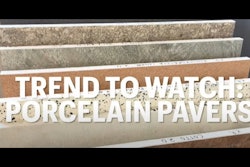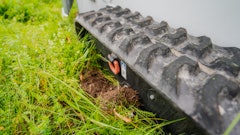
Laura Gunderman, owner of Natural Stone & Tile in Indianapolis, Indiana, first encountered porcelain pavers from Italian manufacturers about 10 years ago.
“The tile companies I was working with in Italy decided to branch into outdoor living,” Gunderman says. “I thought the product was amazing and had all the beauty and benefits that concrete pavers and brick pavers of the world wouldn’t have. I like that contemporary feel. I like to be a little bit more edgy.”
While Gunderman was eager to get the product in front of landscape contractors, she concedes that like many trends, this one was slow to make its way to the Midwest.
“No matter what the trend is, things happen in Indiana and the central part of the United States last,” Gunderman says, adding that California, New York and Miami would be more likely to see the trends first. “I was ahead of my time trying to promote it here, and I just didn’t get as much traction as I would have liked to have had.”
Pierre Bridger, director of operations for Vibrant Outdoors in Indianapolis, Indiana, agrees that there is a disconnect in the central U.S. from a marketing standpoint to the homeowner.
He attributes this in part to landscape pros’ hesitancy to install the pavers due to concerns about the durability, installation process, saw cuts and freezing and thawing cycles.
“There are distributors that have had these products for years, but there hasn't been enough training in this market to give contractors a feeling of, ‘Hey, I can do this. This is not so difficult,’” Bridger says. “In our market, no one wants to make a financial mistake where you install a 1,200-square-foot porcelain paver system and it's wrong. There is just a lack of comfort with so many contractors that they shied away from it. We want to change that.”
Bountiful benefits
Contractors need not be hesitant about porcelain pavers, however, because they tout many benefits.
One of the best parts about porcelain pavers, Gunderman says, is that they are engineered for colder-weather climates.
“Most of Europe is a cold-weather climate like here, but they like to spend time outdoors like we like to spend time outdoors,” Gunderman says.
Because the pavers are nonporous, nothing will be absorbed into them, meaning they also won’t stain. Plus, freeze-thaw cycles will not affect them, so they will not break apart like a concrete or brick paver.
“You can flip a greasy cheeseburger on the paver, and you can pick it up. The cheese will be there, but you can easily clean it off. It won't stain it. You can spill a bottle of red wine on your porcelain paver and hose it right down,” Gunderman says. “If it’s winter and snowy and icy, you can (put) ice melt on it and it’s not going to hurt it. You don’t seal it because you can’t, and it’s going to look beautiful all the time.”
Bringing the pavers to life
Before installing porcelain pavers, contractors should be aware of the differences between indoor and outdoor pavers.
The two biggest differences, Gunderman says, are thickness and surface texture. While indoor porcelain tile is about 1 centimeter thick with a wide variety of surfaces such as natural, textured and polished, outdoor pavers are 2 centermeters thick and feature a textured surface for slip resistance.
While many homeowners immediately think of placing the tiles around a pool, Gunderman says homeowners can also enjoy it over a concrete slab, over a crushed gravel base or even by retrofitting an existing deck.
“Let’s say you have an existing wooden deck, you hate maintaining it, (and you’re) constantly resealing it or power washing,” Gunderman says. “You can take the deck boards up, apply a plastic grate to the wood joist structure and loose lay the pavers over the top with space or tabs to hold them in place. So, you've now retrofitted your deck into a porcelain paver deck, and you now have this beautiful porcelain paver.”
The installation itself doesn’t have to be a headache either.
For example, some systems include a pedestal system, where there’s a pedestal for each 24-inch by 24-inch paver, making them easy to level.
“From that standpoint, we like the idea of not having to spend as much labor,” Bridger says.
No matter the system, Bridger recommends that contractors undergo training on how to install porcelain pavers.
“There are people in the general public that know about these. You need to be able to provide a solution for them,” Bridger says. “In order for us to do that now, we need a ton of training, as much education as we can get and as much experience from the operational side at installing these.”
Additionally, before installing, contractors should be prepared to answer the following questions from homeowners:
- What’s your level of experience with this material?
- Where is the material coming from?
- Is the manufacturer a strong company?
- What’s the price?
- Is there a warranty?
To help ease any customer concerns, Bridger says contractors should emphasize that while the material is more expensive, it’s also a lot more durable.
“It lasts so much longer with virtually no maintenance,” Bridger says. “It costs more money, but the durability and the lack of maintenance are going to pay you back in the long run.”
Did you know?
To increase the push for porcelain pavers and to combat supply chain challenges during COVID-19, several Italian paver manufacturers decided to open plants in the U.S.
As of now, Gunderman says there are 810 factories in Tennessee that are within a good distance of where the clays are that make the great products.
“They're maybe more stylized because they're made for the global market, but it’s just another way of reinventing themselves as to how to keep gaining market share,” Gunderman says.




















